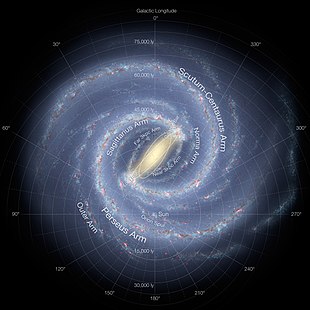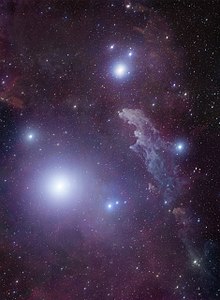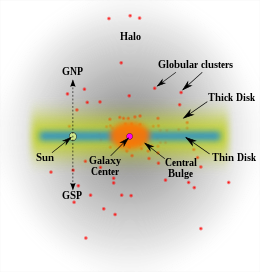星族

星族是沃尔特·巴德在1944年对银河系内的恒星群创建的分类。在巴德文章的摘要中,他认识到扬·欧特在1926年就已经设想过这种类型的分类[1]。
巴德观察到,较蓝的恒星与旋臂强烈相关,黄色恒星在中心星系核球附近和在球状星团内占主导地位[2]。两个主要的划分被定义为星族I和星族II;1978年新增了另一个新的假设划分,称为星族III 。
在星族类型中,发现它们各自观测到的恒星光谱存在显著差异。这些后来被证明是非常重要的,可能与恒星的形成有关,观察到运动学[3]恒星年龄,甚至螺旋和椭圆星系中的星系演化。这三个简单的星族类别根据它们的化学成分或金属量对恒星进行了有效的划分[4][5][3]。
根据定义,每个星族都显示出金属含量下降,表明恒星年龄增加的趋势。因此,宇宙中最早的恒星(金属含量很低)被认为是星族III,老恒星(金属丰度低)被视为星族II,最近的恒星(高金属丰度)被视是星族I[6]。太阳被认为是星族I,是一颗较新的恒星,金属丰度相对较高,为1.4%。请注意,天体物理学命名法认为任何比氦重的元素都是金属,包括化学的非金属,如氧[7]。
恒星发展
[编辑]对恒星光谱的观测表明,与太阳相比,比太阳年龄大的恒星含有更少的重元素[3]。这立即表明,金属量是通过恒星核合成的过程通过恒星的世代演化而来的。
第一批恒星的形成
[编辑]根据现时的宇宙学模型,大爆炸中产生的所有物质大多是氢(75%)和氦(25%),只有极少数的其它轻元素组成,如锂和铍[8]。当宇宙充分冷却后,第一批恒星以没有任何金属污染的星族III的形式诞生。据推测,这影响了它们的结构,使它们的恒星质量成为太阳质量的数百倍。相对的,这些大质量恒星也演化得非常快,它们的核合成过程创造了前26种元素(在周期表中高达铁)[9]。
许多恒星模型理论表明,大多数高质量III族恒星都会迅速耗尽燃料,很可能在能量极高的不稳定状态中爆炸。这些爆炸会彻底分散它们的物质,将金属喷射到星际介质(ISM)中,并融入到下一代恒星中。它们的毁灭表明,在银河系中应该观测不到高质量的III族恒星[10]。然而,因为高红移星系的光起源于宇宙早期的历史,一些III族恒星可能出现在高红移星系中[11]。科学家们在银河系旋臂的联星系统中发现了一颗金属量相较于太阳极其小的超贫金属恒星的证据。这一发现开启了观测更古老恒星的可能性[12]。
恒星质量太大,无法产生成对不稳定的超新星,很可能会通过一个被称为光致蜕变的过程坍塌成黑洞。在这个过程中,一些物质可能以相对论性喷射的形式逃逸,这可能将第一批金属散布到宇宙中[13][14][a]
观测到的恒星形成
[编辑]迄今为止观测到的最古老的恒星[10],被归类为星族II的星族,具有非常低的金属量[16][6];随着下一代恒星的诞生,它们变得更加富含金属,因为它们形成的气体星云接受了前几代恒星从星族III制造的富含金属的宇宙尘埃。
当这些星族II的恒星死亡时,它们通过行星状星云和超新星将富含金属的物质返回星际介质,进一步富集星云,而新恒星又由这些星云形成。这些最年轻的恒星,包括太阳,因此具有最高的金属含量,被称为星族I恒星。
巴德的化学分类
[编辑]第一星族星
[编辑]

第一星族星(亦称星族Ⅰ星)包含相当数量比氦重的元素(天文学中统称为“金属”)。这些重元素的来源是上一代恒星经由超新星爆炸,或来自行星状星云物质扩散的过程散布出来的。 星族I,或称富金属恒星,是三个星族中金属丰度最高的年轻恒星,更常见于像银河系这种星系的旋臂。太阳是富含金属恒星的一个例子,被认为是一颗星族I中间的恒星,而类似太阳的天坛座μ则富含金属[17]。
星族I的恒星通常具有绕着银河中心的规则椭圆轨道,并且有着较低的相对速度。早期有人假设,星族I的高金属内容使它们比其他两类恒星更有可能拥有行星系,因为行星,特别是类地行星,被认为是由金属的吸积形成的[18]。然而,从开普勒空间天文台观测的数据发现,在具有一定金属量的恒星周围有较小的行星,而只有较大的、潜在的气态巨行星集中在金属量相对较高的恒星周围:这一发现对气态巨行星形成的理论有所启发[19]。介于星族I和星族II之间的是中间星盘族。
第二星族星
[编辑]

第二星族星(星族II),或称贫金属星,是指那些比氦重的元素相对较少的恒星。这些天体形成于宇宙早期。在银河系中心附近的核球中,中间的星族II恒星很常见,而在星系晕中发现的星族II恒星更古老,因此更缺乏金属[20]
第二星族星的一个特征是,尽管它们的总体金属量较低,但与第一类恒星相比,它们的“α过程元素”(由氦核作用产生的元素,如氧和氖)相对于铁(Fe)的比例往往更高;现时的理论认为,这是II型超新星在形成时对星际介质有更重要贡献的结果,而Ia型超新星金属富集发生在宇宙发展的后期[21]。
科学家们在几次不同的调查中瞄准了这些最古老的恒星,包括Timothy C.Beers等人的HK物镜棱镜巡天[22],和和汉堡-ESO对诺伯特·克里斯特利布等等的巡天[23],而最初是起源于微弱的类星体。到目前为止,他们已经发现并详细研究了大约十颗超贫金属星(UMP)(如斯涅登星、凯雷尔星、 BD +17° 3248)和迄今为止已知的三颗最古老的恒星:HE 0107-5240、HE 1327-2326和HE 1523-0901。卡福星是在2012年使用斯隆数字化巡天数据发现的,它被确定为迄今为止金属含量最低的超贫金属星。然而,2014年2月,在SkyMapper天文量测数据的帮助下,宣布发现了一颗金属丰度更低的恒星,SMSS J031300.36-670839.3。HD 122563(一颗红巨星)和HD 140283(一颗次巨星)在金属贫乏方面不那么极端,但更接近、更明亮,因此更为人所知。
第二星族星的年龄比第一星族星大了许多,但是却被分配了关系相反的数字来区分,这是历史上遗留下来的原因,因为在第一次对恒星做巡天的探测时,那时并不明了某一类恒星的金属含量会比另一类恒星多的原因。
第三星族星
[编辑]


第三星族星(星族III)[24]是一类假设的大质量、明亮和炽热的恒星群体,可能除了附近其它早期星族III超新星的喷出物混合之外,几乎没有“金属”的恒星。
星族III这个词最早是由Neville J.Woolf在1965年提出的[25][26]。 这类恒星很可能存在于非常早期的宇宙中(即高红移),并可能开始产生比氢更重的化学元素,这是我们所知的行星和生命后期形成所需的[27][28]。
第三星族星的存在是从物理宇宙学推断出来的,但它们还没有被直接观测到。在宇宙中一个非常遥远的引力透镜星系中发现了它们存在的间接证据[29]。它们的存在可能解释了这样一个事实,即在类星体的发射光谱中观察到了重元素,而这些元素原本不可能在大爆炸中产生[9]。它们也被认为是暗蓝星系的组成部分。这些恒星很可能引发了宇宙的再电离时期,这是构成大部分星际介质的氢气的主要相变。对星系UDFy-38135539的观测表明,它可能在这一再电离过程中发挥了作用。欧洲南方天文台在宇宙大爆炸后约8亿年的再电离时期,在非常明亮的星系宇宙红移7中,在“z”=6.60发现了一个明亮的早期星族恒星矿穴。星系的其它部分有一些后来更红的星族II恒星[27][30]。一些理论认为星族III有两代恒星[31]。

现时的理论对第一批恒星的质量是否很大存在分歧。一种可能性是,这些恒星比现时的恒星大得多:几百颗太阳质量,可能高达1,000个太阳质量。这样的恒星寿命很短,只有200-500万年[32]。如此大的恒星可能是由于缺乏重元素,和大爆炸后的星际介质温度仍然高得多[来源请求]。相反的,2009年和2011年提出的理论表明,第一批恒星群可能由一颗大质量恒星组成,周围环绕着几颗较小的恒星[33][34][35]。较小的恒星,如果留在出生星团中,会积累更多的气体,无法存活到今天,但2017年的一项研究得出结论,如果一颗0.8太阳质量(M☉)或更小的恒星,在积累更多质量之前从其出生星团中喷出,它可以存活到现在,甚至可能在我们的银河系中[36]。
对HE 0107-5240等极低金属量第二星族星的资料分析表明,这些无金属恒星的质量为20~130太阳质量,这些恒星被认为含有第三星族星产生的金属[37]。另一方面,对与椭圆星系相关的球状星团的分析表明,不稳定对超新星,通常与大质量恒星相关,是其金属量组成的原因[38]。这也解释了尽管已经为较小的星族III恒星构建了模型,为什么没有观测到零金属量的低质量恒星[39][40]。含有零金属量的红矮星或褐矮星星团(可能由不稳定对超新星产生[16])已经被提议为暗物质候选者[41][42],但是通过引力微透镜对这些类型的MACHO的搜索产生了负面结果[来源请求]。
第二星族星被认为是早期宇宙中黑洞的种子,但与直接坍塌黑洞等高质量黑洞种子不同,它们会产生低质量的恒星,如果它们能生长到比预期质量更大的质量,那么它们可能是类星,在氢和氦被较重元素污染之前,大质量黑洞的其它假设种子可能存在于宇宙早期发展阶段。
探测第三星族星(星族III)是美国国家航空航天局詹姆斯·韦伯空间天文台的一个目标[43]。新的光谱调查,如SEGUE或SDSS-II,也可能定位在找出星族III恒星[来源请求]。
2022年12月8日,天文学家报告可能探测到第三星族星[44][45]。
相关条目
[编辑]注解
[编辑]参考资料
[编辑]- ^
Baade, W. The resolution of Messier 32, NGC 205, and the central region of the Andromeda nebula. Astrophysical Journal. 1944, 100: 137–146. Bibcode:1944ApJ...100..137B. doi:10.1086/144650
 .
. The two types of stellar populations had been recognized among the stars of our own galaxy by Oort as early as 1926.
- ^
Shapley, Harlow. Hodge, Paul , 编. Galaxies
 3. Harvard University Press. 1977: 62–63. ISBN 978-0674340510 –通过Archive.org.
3. Harvard University Press. 1977: 62–63. ISBN 978-0674340510 –通过Archive.org.
- ^ 3.0 3.1 3.2 Gibson, B.K.; Fenner, Y.; Renda, A.; Kawata, D.; Hyun-chul, L. Review: Galactic chemical evolution (PDF). Publications of the Astronomical Society of Australia (CSIRO publishing). 2013, 20 (4): 401–415 [17 April 2018]. Bibcode:2003PASA...20..401G. S2CID 12253299. arXiv:astro-ph/0312255
 . doi:10.1071/AS03052. (原始内容 (PDF)存档于2021-01-20).
. doi:10.1071/AS03052. (原始内容 (PDF)存档于2021-01-20).
- ^ Kunth, Daniel & Östlin, Göran. The most metal-poor galaxies. The Astronomy and Astrophysics Review. 2000, 10 (1): 1–79 [3 January 2022]. Bibcode:2000A&ARv..10....1K. S2CID 15487742. arXiv:astro-ph/9911094
 . doi:10.1007/s001590000005. (原始内容存档于2018-09-16) –通过caltech.edu.
. doi:10.1007/s001590000005. (原始内容存档于2018-09-16) –通过caltech.edu.
- ^ Schönrich, R.; Binney, J. Origin and structure of the Galactic disc(s). Monthly Notices of the Royal Astronomical Society. 2009, 399 (3): 1145–1156. Bibcode:2009MNRAS.399.1145S. arXiv:0907.1899
 . doi:10.1111/j.1365-2966.2009.15365.x
. doi:10.1111/j.1365-2966.2009.15365.x  .
.
- ^ 6.0 6.1 Bryant, Lauren J. What makes stars tick. Research & Creative Activity. Indiana University. [September 7, 2005]. (原始内容存档于2016-05-16).
|volume=被忽略 (帮助);|issue=被忽略 (帮助) - ^ Metals. astronomy.swin.edu.au. Cosmos. [2022-04-01].
- ^
Cyburt, Richard H.; Fields, Brian D.; Olive, Keith A.; Yeh, Tsung-Han. Big bang nucleosynthesis: Present status. Reviews of Modern Physics. 2016, 88 (1): 015004. Bibcode:2016RvMP...88a5004C. S2CID 118409603. arXiv:1505.01076
 . doi:10.1103/RevModPhys.88.015004.
. doi:10.1103/RevModPhys.88.015004.
- ^ 9.0 9.1
Heger, A.; Woosley, S.E. The nucleosynthetic signature of Population III. Astrophysical Journal. 2002, 567 (1): 532–543. Bibcode:2002ApJ...567..532H. S2CID 16050642. arXiv:astro-ph/0107037
 . doi:10.1086/338487.
. doi:10.1086/338487.
- ^ 10.0 10.1
Schlaufman, Kevin C.; Thompson, Ian B.; Casey, Andrew R. An ultra metal-poor star near the hydrogen-burning Limit. The Astrophysical Journal. 2018, 867 (2): 98. Bibcode:2018ApJ...867...98S. S2CID 54511945. arXiv:1811.00549
 . doi:10.3847/1538-4357/aadd97
. doi:10.3847/1538-4357/aadd97  .
.
- ^ Xu, Hao; Wise, John H.; Norman, Michael L. Population III stars and remnants in high-redshift galaxies. The American Astronomical Society. 29 July 2013, 773 (2): 83. Bibcode:2013ApJ...773...83X. S2CID 118303030. arXiv:1305.1325
 . doi:10.1088/0004-637X/773/2/83.
. doi:10.1088/0004-637X/773/2/83.
- ^ One of Milky Way's oldest stars discovered. Sci-News. 6 November 2018 [12 June 2020]. (原始内容存档于2018-11-06).
- ^
Fryer, C. L.; Woosley, S. E.; Heger, A. Pair-instability supernovae, gravity waves, and gamma-ray transients. The Astrophysical Journal. 2001, 550 (1): 372–382. Bibcode:2001ApJ...550..372F. S2CID 7368009. arXiv:astro-ph/0007176
 . doi:10.1086/319719.
. doi:10.1086/319719.
- ^
Heger, A.; Fryer, C. L.; Woosley, S. E.; Langer, N.; Hartmann, D. H. How massive single stars end their life. The Astrophysical Journal. 2003, 591 (1): 288–300. Bibcode:2003ApJ...591..288H. S2CID 59065632. arXiv:astro-ph/0212469
 . doi:10.1086/375341.
. doi:10.1086/375341.
- ^ Clark, Stuart. Primordial giant: The star that time forgot. New Scientist. February 2010 [1 February 2015]. (原始内容存档于2015-04-23).
- ^ 16.0 16.1
Salvaterra, R.; Ferrara, A.; Schneider, R. Induced formation of primordial low-mass stars. New Astronomy. 2004, 10 (2): 113–120. Bibcode:2004NewA...10..113S. S2CID 15085880. arXiv:astro-ph/0304074
 . doi:10.1016/j.newast.2004.06.003.
. doi:10.1016/j.newast.2004.06.003.
- ^
Soriano, M.S.; Vauclair, S. New seismic analysis of the exoplanet-host star Mu Arae. Astronomy and Astrophysics. 2009, 513: A49. Bibcode:2010A&A...513A..49S. S2CID 5688996. arXiv:0903.5475
 . doi:10.1051/0004-6361/200911862.
. doi:10.1051/0004-6361/200911862.
- ^
Lineweaver, Charles H. An estimate of the age distribution of terrestrial planets in the universe: Quantifying metallicity as a selection effect. Icarus. 2000, 151 (2): 307–313. Bibcode:2001Icar..151..307L. S2CID 14077895. arXiv:astro-ph/0012399
 . doi:10.1006/icar.2001.6607.
. doi:10.1006/icar.2001.6607.
- ^ Buchhave, L.A.; et al. An abundance of small exoplanets around stars with a wide range of metallicities. Nature. 2012, 486 (7403): 375–377. Bibcode:2012Natur.486..375B. PMID 22722196. S2CID 4427321. doi:10.1038/nature11121.
- ^
van Albada, T. S.; Baker, N. On the two Oosterhoff groups of globular clusters. Astrophysical Journal. 1973, 185: 477–498. Bibcode:1973ApJ...185..477V. doi:10.1086/152434
 .
.
- ^ Wolfe, Arthur M.; Gawiser, Eric; Prochaska, Jason X. Damped Ly‑α systems. Annual Review of Astronomy and Astrophysics. 2005, 43 (1): 861–918 [2024-01-27]. Bibcode:2005ARA&A..43..861W. S2CID 119368187. arXiv:astro-ph/0509481
 . doi:10.1146/annurev.astro.42.053102.133950. (原始内容存档于2018-11-21).
. doi:10.1146/annurev.astro.42.053102.133950. (原始内容存档于2018-11-21).
- ^ Beers, T. C.; Preston, G. W.; Shectman, S. A. A Search for Stars of Very Low Metal Abundance. II. Astronomical Journal. 1992, 103: 1987. Bibcode:1992AJ....103.1987B. S2CID 121564385. doi:10.1086/116207.
- ^ Christlieb, N.; Wisotzki, L.; Reimers, D.; Gehren, T.; Reetz, J.; Beers, T. C. An Automated Search for Metal-Poor Halo Stars in the Hamburg/ESO Objective-Prism Survey. ASP Conference Series. 1998, 666. arXiv:astro-ph/9810183v1
 .
.
- ^
Tominga, N.; et al. Supernova nucleosynthesis in population III 13-50 Msolar stars and abundance patterns of extremely metal-poor stars. Astrophysical Journal. 2007, 660 (5): 516–540. Bibcode:2007ApJ...660..516T. S2CID 119496577. arXiv:astro-ph/0701381
 . doi:10.1086/513063.
. doi:10.1086/513063.
- ^ Green, Louis. Observational Aspects of Cosmology. Sky and Telescope. April 1966, 31: 199. Bibcode:1966S&T....31..199G.
- ^ Thornton, Page. Observational Aspects of Cosmology. Science. March 1966, 151 (3716): 1411–1414,1416–1418 [2024-01-27]. Bibcode:1966Sci...151.1411P. (原始内容存档于2023-05-10).
- ^ 27.0 27.1
Sobral, David; Matthee, Jorryt; Darvish, Behnam; Schaerer, Daniel; Mobasher, Bahram; Röttgering, Huub J.A.; Santos, Sérgio; Hemmati, Shoubaneh. Evidence for Pop III-like stellar populations in the most luminous Lyman-α emitters at the epoch of re-ionisation: Spectroscopic confirmation. The Astrophysical Journal. 4 June 2015, 808 (2): 139. Bibcode:2015ApJ...808..139S. S2CID 18471887. arXiv:1504.01734
 . doi:10.1088/0004-637x/808/2/139.
. doi:10.1088/0004-637x/808/2/139.
- ^ Overbye, Dennis. Astronomers report finding earliest stars that enriched the cosmos. The New York Times. 17 June 2015 [17 June 2015]. (原始内容存档于2019-06-29).
- ^
Fosbury, R.A.E.; et al. Massive star formation in a gravitationally lensed H II galaxy at z = 3.357. Astrophysical Journal. 2003, 596 (1): 797–809. Bibcode:2003ApJ...596..797F. S2CID 17808828. arXiv:astro-ph/0307162
 . doi:10.1086/378228.
. doi:10.1086/378228.
- ^
Best observational evidence of first-generation stars in the universe. Astronomy Magazine. 17 June 2015. 已忽略未知参数
|collaboration=(帮助) - ^
Bromm, V.; Yoshida, N.; Hernquist, L.; McKee, C.F. The formation of the first stars and galaxies. Nature. 2009, 459 (7243): 49–54. Bibcode:2009Natur.459...49B. PMID 19424148. S2CID 10258026. arXiv:0905.0929
 . doi:10.1038/nature07990.
. doi:10.1038/nature07990.
- ^
Ohkubo, Takuya; Nomoto, Ken'ichi; Umeda, Hideyuki; Yoshida, Naoki; Tsuruta, Sachiko. Evolution of very massive Population III stars with mass accretion from pre-main sequence to collapse. The Astrophysical Journal. 2009-12-01, 706 (2): 1184–1193. Bibcode:2009ApJ...706.1184O. ISSN 0004-637X. arXiv:0902.4573
 . doi:10.1088/0004-637X/706/2/1184
. doi:10.1088/0004-637X/706/2/1184  .
.
- ^ Redd, Nola. The universe's first stars weren't loners after all. Space.com. February 2011 [1 February 2015]. (原始内容存档于2018-11-21).
- ^ Thompson, Andrea. How massive stars form: Simple solution found. Space.com. January 2009 [1 February 2015]. (原始内容存档于2019-02-03).
- ^ Carr, Bernard J. Cosmology, Population III. California Institute of Technology. [2024-01-27]. (原始内容存档于2017-10-20).
- ^
Dutta, J.; Sur, S.; Stacy, A.; Bagla, J.S. Modeling the Survival of Population III Stars to the Present Day. The Astrophysical Journal. 2020, 901 (1): 16. Bibcode:2020ApJ...901...16D. S2CID 209386374. arXiv:1712.06912
 . doi:10.3847/1538-4357/abadf8
. doi:10.3847/1538-4357/abadf8  .
.
- ^
Umeda, Hideyuki; Nomoto, Ken'Ichi. First-generation black-hole-forming supernovae and the metal abundance pattern of a very iron-poor star. Nature. 2003, 422 (6934): 871–873. Bibcode:2003Natur.422..871U. PMID 12712199. S2CID 4424736. arXiv:astro-ph/0301315
 . doi:10.1038/nature01571.
. doi:10.1038/nature01571.
- ^
Puzia, Thomas H.; Kissler‐Patig, Markus; Goudfrooij, Paul. Extremely α‐enriched globular clusters in early‐type galaxies: A step toward the dawn of stellar populations?. The Astrophysical Journal. 2006, 648 (1): 383–388. Bibcode:2006ApJ...648..383P. S2CID 9815509. arXiv:astro-ph/0605210
 . doi:10.1086/505679.
. doi:10.1086/505679.
- ^
Siess, Lionel; Livio, Mario; Lattanzio, John. Structure, evolution, and nucleosynthesis of primordial stars. The Astrophysical Journal. 2002, 570 (1): 329–343. Bibcode:2002ApJ...570..329S. S2CID 18385975. arXiv:astro-ph/0201284
 . doi:10.1086/339733.
. doi:10.1086/339733.
- ^ Gibson, Carl H.; Nieuwenhuizen, Theo M.; Schild, Rudolph E. Why are so many primitive stars observed in the Galaxy halo. Journal of Cosmology. 2013, 22: 10163. Bibcode:2013JCos...2210163G. arXiv:1206.0187
 .
.
- ^
Kerins, E.J. Zero-metallicity very low mass stars as halo dark matter. Astronomy and Astrophysics. 1997, 322: 709. Bibcode:1997A&A...322..709K. arXiv:astro-ph/9610070
 .
.
- ^
Sanchez-Salcedo, F.J. On the stringent constraint on massive dark clusters in the galactic halo. Astrophysical Journal Letters. 1997, 487 (1): L61. Bibcode:1997ApJ...487L..61S. doi:10.1086/310873
 .
.
- ^
Rydberg, C.-E.; Zackrisson, E.; Lundqvist, P.; Scott, P. Detection of isolated population III stars with the James Webb Space Telescope. Monthly Notices of the Royal Astronomical Society. March 2013, 429 (4): 3658–3664. Bibcode:2013MNRAS.429.3658R. arXiv:1206.0007
 . doi:10.1093/mnras/sts653.
. doi:10.1093/mnras/sts653.
- ^ Wang, Xin; et al. A strong He II λ1640 emitter with extremely blue UV spectral slope at z=8.16: presence of Pop III stars?. 8 December 2022. arXiv:2212.04476
 [astro-ph.GA].
[astro-ph.GA].
- ^ Callaghan, Jonathan. Astronomers Say They Have Spotted the Universe's First Stars - Theory has it that "Population III" stars brought light to the cosmos. The James Webb Space Telescope may have just glimpsed them.. Quanta Magazine. 30 January 2023 [31 January 2023]. (原始内容存档于2023-02-09).
进阶读物
[编辑]- Gibson, B. K.; et al. Review: Galactic Chemical Evolution (PDF). Publications of the Astronomical Society of Australia. 2013 [17 April 2018]. (原始内容 (PDF)存档于2021-01-20).
- Ferris, Timothy. Coming of Age in the Milky Way. William Morrow & Co. 1988: 512. ISBN 978-0-688-05889-0.
- Kippenhahn, Rudolf. 100 Billion Suns: The birth, life, and death of the stars. Princeton University Press. 1993. ISBN 978-0-691-08781-8 –通过Google Books.
